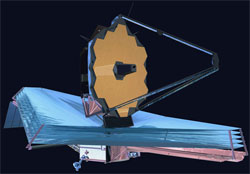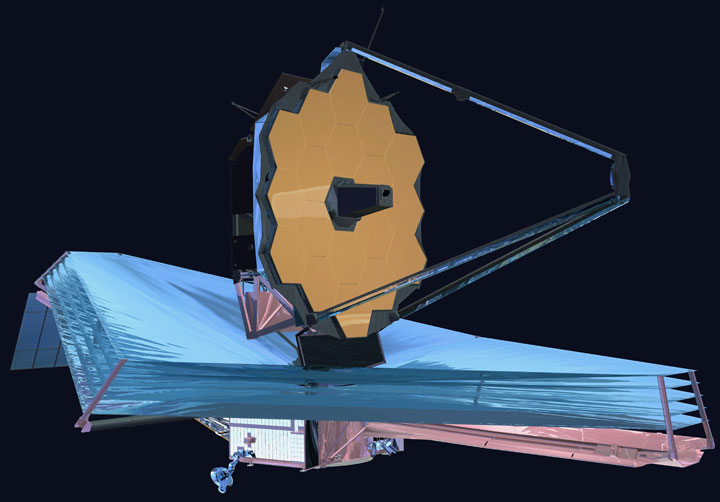Landmarks: The Inflationary Universe
Focus Landmarks feature important papers from the archives of the Physical Review.
30 years ago, a report in Physical Review D utterly transformed scientific thinking about the origin of the universe. New ideas from particle physics, the paper showed, implied that the universe might have undergone a phase of very rapid expansion in the first fractions of a second of its existence. This inflationary episode, as it was dubbed, could explain how our universe came to have its observed density and uniformity. Inflation not only became a central tenet of cosmological theory; it also meant that any aspiring cosmic theorist had to learn particle physics.
In the 1970s, particle theorists began to construct grand unified theories (GUTs), which proposed that at temperatures or energies above about 1015 billion electron-volts (GeV), the electromagnetic force and the strong and weak nuclear forces are identical. In standard big bang models, the cosmos started out hot enough to achieve that grand unified state. Then, at a cosmic age of about 10-35 seconds, the strong nuclear force parted company from the still-unified electroweak force. One unwanted consequence of this transition, theorists realized, was that it would create an abundance of isolated north and south magnetic poles, or monopoles–a phenomenon inconsistent with cosmic observations.
Two seemingly unrelated problems also existed in cosmology at the time. First, the uniformity problem: the universe has expanded so rapidly that there hasn’t been time for all regions of today’s observable universe to equalize their temperatures and densities by exchanging matter and energy. Why, then, does the universe look more or less the same everywhere?
The second puzzle was that our universe appears to be approximately “flat”–on the largest distance scales, space has little or no curvature. But in standard cosmological models, any universe that starts out with a little bit of curvature, positive or negative, diverges away from flatness as the universe expands. A universe that’s almost flat after more than ten billion years is as hard to arrange as a pencil that remains balanced on its point for eons.
Late in 1979, Alan Guth, then at the Stanford Linear Accelerator Center in California, realized that a solution to the monopole problem he had recently worked out with a colleague [1] could also solve these two major puzzles. The solution involved an ingredient of GUTs known as the Higgs field, which is assumed to pervade all of space. As the universe expanded and cooled, the strong force parted company with the others when the Higgs field switched from one value to another. To solve the monopole problem, Guth and Henry Tye, both at Cornell University the year before, supposed that the Higgs field didn’t switch immediately but got stuck for some time at the wrong value. The situation was something like a ball being trapped in a depression at the top of a hill, preventing it from rolling down to the valley below. A delayed Higgs transition meant lower monopole production.
Guth began to wonder what the delayed transition would mean for cosmic expansion. When the Higgs field was stuck at the wrong value, it became the dominant energy in the universe, with the strange property of making the universe expand exponentially with time, in contrast to the usual slower expansion for a universe filled only with matter and radiation.
“Inflation,” as Guth called this exponential expansion, solves the uniformity problem because it takes a piece of the early universe small enough to have been smoothed out by internal processes and blows it up into a region far larger than we can see today. He also showed that inflation pushes the universe closer to perfect flatness the longer it goes on.
In his paper, Guth admitted a serious problem with his model. The Higgs field doesn’t complete its transition in every region of space, leaving an inhomogeneous universe that is nothing like the universe we see. After just a year, however, others found ways to adjust the theory and avoid this problem [2].
Rocky Kolb, now at the University of Chicago, says that at the time a few young particle physicists were beginning to get interested in cosmology, but that to him the monopole problem seemed more urgent than the other cosmic puzzles. “We didn’t have any inkling [inflation] would be the powerful concept it turned out to be.” But now, he says, inflation is ubiquitous in cosmology and promises to explain much more, including the origin of structure, such as galaxies and galaxy clusters.
–David Lindley
David Lindley is a freelance science writer, now retired. His most recent book is The Dream Universe: How Fundamental Physics Lost Its Way (Penguin Random House, 2020).
References
- A. H. Guth and S.-H. H. Tye, “Phase Transitions and Magnetic Monopole Production in the Very Early Universe,” Phys. Rev. Lett. 44, 631 (1980)
- Andreas Albrecht and Paul J. Steinhardt, “Cosmology for Grand Unified Theories with Radiatively Induced Symmetry Breaking,” Phys. Rev. Lett. 48, 1220 (1982); A. D. Linde, “A New Inflationary Universe Scenario: A Possible Solution of the Horizon, Flatness, Homogeneity, Isotropy, and Primordial Monopole Problems,” Phys. Lett. B 108 389 (1982)





